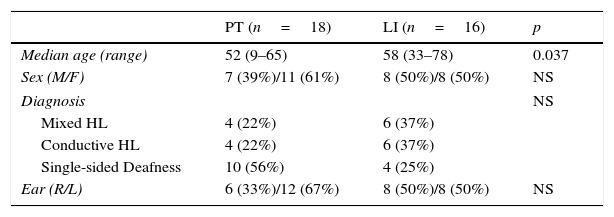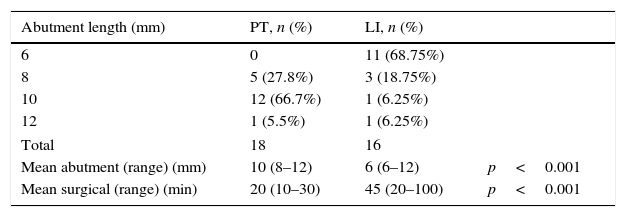To compare the punch technique and linear incision with soft tissue reduction for the placement of auditory osseointegrated implants (AOI) and analyze results of osseointegration obtained with the punch technique as measured with the Implant Stability Quotient (ISQ).
MethodsCase review of 34 patients who received auditory osseointegrated implants between January 2010 and July 2015 and were divided into two groups according to the surgical technique: 18 with the punch technique (PT) and 16 with the linear incision technique (LI). Minimum follow-up was four months (mean: 24 months; range 4–64 months). Included in the analysis were patient profiles and records of the demographic data, surgical indications, surgical technique, implant placement, surgical time, intraoperative complications, as well as postsurgical complications (Holgers classification) and implant stability quotients (ISQ).
ResultsUse of larger abutments was significantly greater in the PT group (PT, 10mm; LI, 6mm, p<0.001). The PT technique resulted in a shorter procedure than the LI (PT, 20min; LI, 45min, p<0.001). Holgers classification scores identified significantly fewer skin complications one week after surgery for the PT group; however, only small differences were seen between the two groups at the one- and three-month control visits.
ConclusionsAs shown for our cohort, the punch technique for surgical placement of AOI is faster and presents fewer immediate postoperative complications when compared to the linear incision technique. The clinical application of the ISQ is a useful, easy method to demonstrate the status of osseointegration and, thus, the stability of the device.
Comparar la técnica de perforación con la de incisión lineal con reducción de tejidos blandos en la colocación de implantes osteointegrados y analizar los resultados de la osteointegración obtenidos con la técnica de perforación (PT) medidos con el coeficiente de estabilidad del implante (Implant Stability Quotient [ISQ]).
MétodosTreinta y cuatro pacientes recibieron implantes osteointegrados entre enero 2010 y julio 2015, dividiéndolos en 2 grupos: 18 con PT y 16 con técnica de incisión lineal (LI). El seguimiento mínimo fue de 4 meses (media: 24 meses; rango 4-64 meses). Analizamos los perfiles de los pacientes, datos demográficos, indicaciones quirúrgicas, técnica quirúrgica, colocación del implante, tiempo de cirugía, complicaciones intraoperatorias y postoperatorias (clasificación de Holgers) y el ISQ.
ResultadosEl uso de pilares más largos fue significativamente mayor en el grupo PT (PT: 10mm; LI: 6mm, p<0,001). La PT fue más corta que la LI (PT: 20min; LI: 45min, p<0,001). La clasificación Holgers identificó menos complicaciones cutáneas a la semana poscirugía en el grupo PT de forma significativa; de hecho, solo se apreciaron pequeñas diferencias entre los 2 grupos en las visitas al mes y los 3 meses.
ConclusionesComo se muestra en nuestro estudio, la PT para la colocación de implantes osteointegrados es más rápida y presenta menos complicaciones cutáneas postoperatorias inmediatas cuando se compara con la técnica LI. La aplicación clínica del ISQ es útil y fácil para objetivar la osteointegración y así la estabilidad del implante.













